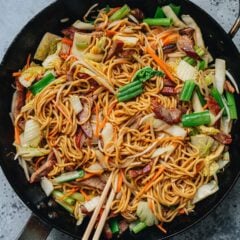
Roast Pork Lo Mein (叉烧捞面)
Roast pork lo mein is one of my favorite comfort dishes that transforms leftover Chinese BBQ pork into a brand-new meal. It combines tender slices of char siu with springy noodles, crisp vegetables, and a glossy savory sauce.
Ingredients
- 10 oz fresh lo mein noodles (or 8 oz / 225 g dried lo mein noodles)
Sauce
- 1/4 cup chicken stock
- 2 tablespoons oyster sauce
- 1 tablespoon Shaoxing wine
- 1 teaspoon light soy sauce
- 1 teaspoon dark soy sauce
- 2 teaspoons sugar
Stir Fry
- 3 tablespoons vegetable oil
- 8 oz char siu , sliced into thin strips (*Footnote 1)
- 1 (2 oz) carrot , cut into thin strips
- 4 dried shiitake mushrooms , rehydrated and sliced thinly
- 4 green onions , cut into 1 inch lengths, whites and greens separated
- 1/4 (1/2 lb) napa cabbage , slice white part 1/2” thick and greens 1” thick (yield 4 cups sliced)
- 1/2 teaspoon salt
- 2 cups bean sprouts
Instructions
- Boil the noodles according to the package instructions minus 1 minute, until al dente. Rinse with tap water to stop cooking, drain, and set aside. (*Footnote 2)
- Whisk all the sauce ingredients together in a medium-sized bowl.
- Heat 1 tablespoon of vegetable oil over high heat in a 12” pan (or a wok). Once hot, add the sliced shiitake mushrooms, carrot, and green onion whites, and saute for 2 minutes, until the vegetables are soft.
- Next, add the sliced napa cabbage and saute for another 1 to 2 minutes, until the cabbage starts to soften. Sprinkle with 1/2 teaspoon salt and toss to mix. Turn to low heat and transfer all the vegetables to a large plate.
- Add the char siu strips and turn to medium heat. Cook until the edges are lightly browned, then transfer it to the plate with the vegetables.
- Add the remaining 2 tablespoons of vegetable oil and the noodles. Toss the noodles to coat evenly with oil. Pour in the sauce and toss again to coat. Add the bean sprouts and toss again, 1 minute or so.
- Add back the vegetables and char siu, and the scallion greens. Toss to mix again. Taste the noodles and vegetables. Adjust seasoning by sprinkling a little more salt if needed. If the vegetables are still too tough, cover the pan and steam for another 1 to 2 minutes, until the vegetables are cooked to your preferred texture. Transfer to serving plates and serve as a main dish.
Notes
- You can use other types of cooked pork, like pulled pork, to cook this dish and get a great result too. If using uncooked pork, pork tenderloin is the best option. Thinly slice the pork against the grain into 1/8” (3 mm) pieces, marinate with 1/2 tablespoon Shaoxing wine, 1 teaspoon cornstarch, and 1/4 teaspoon salt. When cooking the pork, add 1/2 tablespoon oil first, and sear until just cooked through.
- If you’re using a wok to make this dish, you can boil the noodles in the wok. It’s usually faster this way because you will need less water to cook the noodles.
Nutrition
Serving: 1serving, Calories: 457kcal, Carbohydrates: 62.3g, Protein: 26.3g, Fat: 13.1g, Saturated Fat: 2.9g, Cholesterol: 47mg, Sodium: 724mg, Potassium: 723mg, Fiber: 3.9g, Sugar: 11.1g, Calcium: 96mg, Iron: 4mg